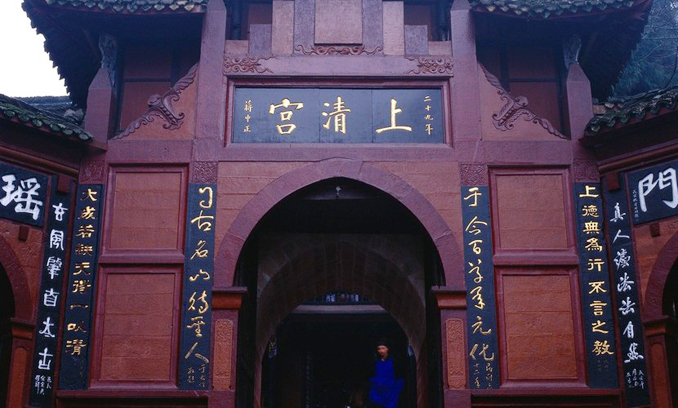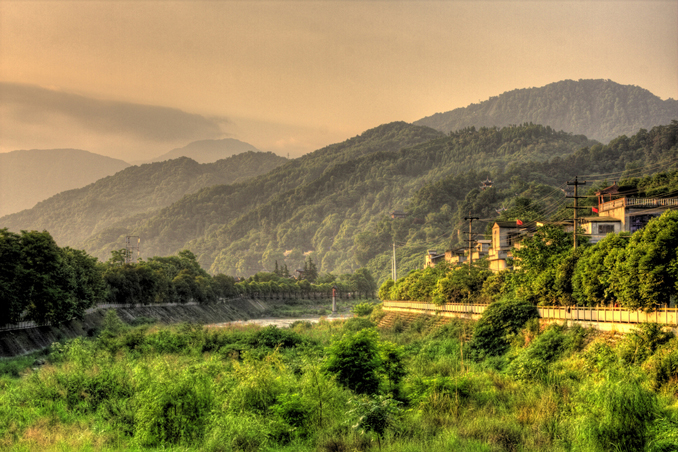Written by: Feng Yang
Posted on: June 12, 2015 | 
A view of Mount Qingcheng
Flooding and drought were frequent occurrences on the Chengdu Plain before the advent of Li Bing. The Minjiang River, the second longest tributary of the Yangtze River, often breached its dikes at Guanxian County, now Dujiangyan City, in the summer, flooding vast areas on both banks. The scourge went from bad to worse as sand and mud carried by the river in its water settled and raised the river bed. Moreover, Mount Yulei in the southwest of Guanxian blocked the river from flowing eastward. For this reason, areas east of Guanxian would suffer from drought while areas in the west were being flooded.
Shortly after he took up the post as the governor of the area, Li Bing decided to harness the river. He worked with his son and the locals for the job. Instead of building a dam to contain the flood water, they made the best use of the favorable topographic conditions and built a dike to divide the river midstream into two channels. The channel west of the fish-like dike, known as the Outer River, is in fact the mainstream of the Minjiang River, and was designed to divert flooding water. The channel east of the dike, or the Inner River, was to divert water for irrigation. The far end of the dike is called "Fish Mouth", so cleverly constructed that it can divide the water volume in the right proportions. In spring, when the water flow is small and the farmland requires water, 60 percent of the Minjiang River water flows into the Inner River, and only 40 percent into the Outer River. In the flooding season, this proportion is the other way around: 60 percent of the water in the Minjiang River flows into the Outer River and 40 percent into the Inner River to prevent the farmland from being flooded.

At about 1,000 meters downstream, the Inner River reaches Baopingkou, the entrance of a 20 meter-wide tunnel dug through Mount Yulei. Prior to the invention of gunpowder, it was not easy to tunnel through the mountain. Li Bing, however, was not to be daunted. Upon his orders, workers heated rocks with fire to expand them, and when they were hot enough, cold water was poured on them to make them contract and crack. The entrance of the tunnel automatically adjusts the volume of water from the Inner River. It diverts excess water from the river into the irrigation system.
While diverting flood waters in the summer, the concave dike between the Fish Head and Baopingkou washes sand in the Inner River down into the Outer River, and is therefore called "Feishayan" (meaning “Sand Flying Dike”). When water from the Inner River rises above its limit, the excess water then flows over the Sand Flying Dike into the Outer River along with the mud and sand inside it, which would otherwise settle to silt the Inner River and Baopingkou channels. In the case of a devastating flood, the Sand Flying Dike automatically collapses to allow flow of water from the Inner River back into a main tributary of the Minjiang River.
The principle for construction of the Dujiangyan Project is quite simple, but the wisdom that the project represents has won admiration from hydraulic experts in the past 2,000 years after it was built. All the materials used in the project were locally available. The area is overgrown with bamboo. Bamboo slices were used to make cages to hold pebbles with, which were then used as construction materials. Numerous irrigation systems were built in ancient times in other countries – Nur-Mammurabi Canal on the Euphrates in Babylon and the canals in ancient Rome. However, these have long been deserted. In contrast, the Dujiangyan Water Control System is still used, to the benefit of millions.

Mount Qingcheng, 15 kilometers to the south of Dujiangyan, has been a holy shrine of Taoism, the indigenous religion of China, for well over 1,800 years. Pine, cypress, dawn redwood, nanmu (trees of phoebe ) and Chinese sweet gum in different shades of green cover this "green world", as the mountain is known. In those dense forests, cliffs and valleys, one can hear nothing but the whistling of wind and the singing of streams and birds, for which Mount Qingcheng has been famed as the “mountain of tranquility”.
Mount Qingcheng was destined to become the birthplace of Taoism due to its tranquility. In 143 AD, a man named Zhang Daoling came to Mount Qingcheng, built a simple hut on his own, and began to propagate his doctrines that were to develop into Taoism. Believers of Taoism call Zhang Daoling the "Heavenly Master", and Mount Qingcheng is therefore referred to as the "Heavenly Master's Mountain". Many sects of the religion are attributed to Mount Qingcheng, where their founders stayed for cultivation of their inner world. With support from the imperial court of the Tang Dynasty (618-907), Taoism prospered, and consequently, Mount Qingcheng became the religious center of the country. During its heyday, it had more than 70 Taoist temples. About half of these buildings are still in good shape.
On Mount Wudang, another holy shrine for Taoism, the palaces and temples are quite similar to imperial palace buildings in grandeur and magnificence. In comparison, Taoist buildings on Mount Qingcheng are simple and plain, or more compatible with the doctrines of Taoism. It is said that Taoism originates from the teachings of Lao Zi, a Chinese philosopher who lived about 2,500 years ago. Lao Zi stood for a life free from worldly matters; a life of peace and tranquility that blends with nature.
The Palace of Supreme Heaven on the highest peak of Mount Qingcheng is known not only as a holy shrine for Lao Zi, but also for its simple yet beautiful buildings. The main gate, archways and rails are all structures of stone and the main hall is wooden, with a visual impact strong enough to bring visitors back to ancient times when locally available materials had to be used in construction. Looking down from the temple after dark in the summer, people can see sporadic lights in the mountain; at one time just a few twinkling, and at another, hundreds or thousands just like the star-studded sky. These lights, it is said, are "lamps" lit by the God of Mount Qingcheng. The fact is that they are jack-o’-lanterns.
You may also like: